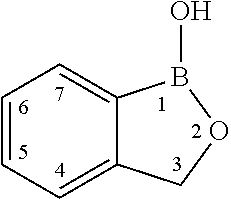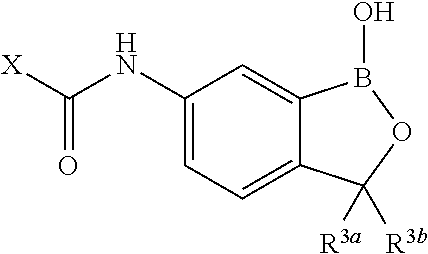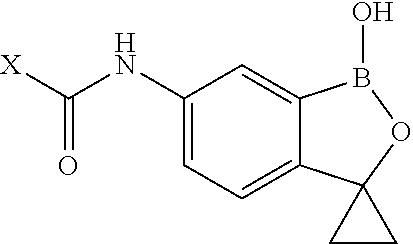Boron-containing small molecules as antiprotozoal agents
a small molecule and protozoa technology, applied in the field of boron-containing small molecules as antiprotozoal agents, can solve the problems of global rise of protozoa resistant to antimicrobials in general, and pose a major threa
- Summary
- Abstract
- Description
- Claims
- Application Information
AI Technical Summary
Problems solved by technology
Method used
Image
Examples
example 1
1 4-Fluoro-N-(1-hydroxy-3-methyl-1,3-dihydro-benzo[c][1,2]oxaborol-6-yl-2-trifluoromethyl benzamide
[0288]
[0289]To a solution of 2-acetylphenylboronic acid (1.00 g, 6.1 mmol) in 40 ml 3:1 i-PrOH:H2O, sodium borohydride (941.0 mg, 24.3 mmol 4.0 eq.) was added in portions. The reaction solution was allowed to stir for 2.5 hrs at room temperature then the reaction was quenched by dropwise addition of 6M HCl until gas evolution ceased and the reaction mixture reach pH=1-2. Once the pH was established, the aqueous solution was allowed to stir for an additional 0.5 hr. The aqueous solution was then extracted with DCM and the combined DCM extracts were dried over Na2SO4. The DCM was evaporated and the remaining clear, colorless oil was subjected to SiO2 chromatography using 3:7 EtOAc:heptane as the eluent. The desired product was recovered as clear, colorless, thick oil. Amount obtained, 741 mg, (82% yield).
[0290]To 4.0 ml fuming HNO3 at −45° C. was added a solution of 3-methyl-3H-benzo[c][...
example 2
Trypanosoma brucei brucei High-Throughput Screening Assay Procedure
[0610]All experiments were conducted with the bloodstream-form trypanosome T. brucei brucei 427 strain obtained from Seattle Biomedical Research Institute (Seattle, Wash.). Parasites were cultured in T-25 vented cap flasks and kept in humidified incubators at 37° C. and 5% CO2. The parasite culture media was complete HMI-9 medium (c.f. Hirumi, Journal of Parasitology 1989, Volume 75, page 985 et seq) containing 10% FBS, 10% Serum Plus medium and penicillin / streptomycin. To ensure log growth phase, trypanosomes were sub-cultured at appropriate dilutions every 2-3 days.
In Vitro Drug Sensitivity Assays
[0611]Approximately 50 microliters of log phase cultures were diluted 1:10 in HMI-9 and 10 uL of the diluted culture was removed and counted using a hemocytometer to determine parasite concentration. Parasites were diluted by addition of an appropriate volume of HMI-9 to achieve a final parasite concentration of 2×105 / mL. ...
example 3
Method for Estimation of Kinetic Solubility of Compounds of the Invention
[0613]The kinetic solubilities of compounds were estimated using a nephelometric (light scattering) method. Briefly, compounds were serially diluted in DMSO, followed by dilution in PBS pH 7.4. After incubation, the amount of light scattered by a compound at each concentration was measured. Clear solutions of soluble compounds do not scatter a light beam passed through the sample well and produce no signal. At concentrations above the solubility limit, the compound precipitates and the precipitant in the well scatters the light, generating a signal. Higher levels of precipitant in a well scatter more light and produce a stronger signal.
[0614]A stock solution of compound (25 mM in DMSO) was prepared, and was serially diluted in DMSO in two-fold increments in a row of a 96 well plate to a lowest concentration of 24 μM. A duplicate plate was prepared by transfer of half of the volume of each well to a new plate. E...
PUM
 Login to View More
Login to View More Abstract
Description
Claims
Application Information
 Login to View More
Login to View More - R&D
- Intellectual Property
- Life Sciences
- Materials
- Tech Scout
- Unparalleled Data Quality
- Higher Quality Content
- 60% Fewer Hallucinations
Browse by: Latest US Patents, China's latest patents, Technical Efficacy Thesaurus, Application Domain, Technology Topic, Popular Technical Reports.
© 2025 PatSnap. All rights reserved.Legal|Privacy policy|Modern Slavery Act Transparency Statement|Sitemap|About US| Contact US: help@patsnap.com



